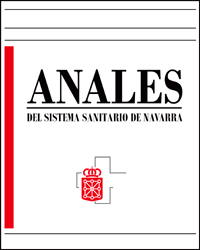Bilateral subgaleal hematoma after a robot-assisted radical prostatectomy: an uncommon complication
DOI:
https://doi.org/10.23938/ASSN.1047Keywords:
Robot-assisted radical prostatectomy, Subgaleal hematoma, Steep TrendelenburgAbstract
Robot-assisted radical prostatectomy is a relatively recent technique. Its advantages include less invasiveness, better pain management, and reduced length of hospital stay1. The surgical time, once the learning curve is over, is about two hours.
Some of the requirements when using this technique can be challenging for the anesthesiologist. The patient must be positioned in steep Trendelenburg (> 30º), a pneumoperitoneum established, and a deep muscular blockade is desirable. This potentially helps impair homeostasis, ventilation, and cervical and cephalic venous-lymphatic drainage. The presence of increased intraocular or intracranial pressures is a contraindication for performing this technique.
Common risks of the steep Trendelenburg position, which increase with time, include intraoperative hypotension, and soft-tissue edema (tongue, eyelids, conjunctiva, and scalp); severe complications are rare.
Downloads
References
NIKLAS C, SAAR M, BERG B, STEINER K, JANSSEN M, SIEMER S et al. da Vinci and open radical prostatectomy: comparison of clinical outcomes and analysis of insurance costs. Urol Int 2016; 96(3): 287-294. https://doi.org/10.1159/000431104
ACETO P, BERETTA L, CARIELLO C, CLARONI C, ESPOSITO C, FORASTIERE EM et al. Joint consensus on anesthesia in urologic and gynecologic robotic surgery: specific issues in management from a task force of the SIAARTI, SIGO, and SIU. Minerva Anestesiol 2019; 85(8): 871-885. https://doi.org/10.23736/s0375-9393.19.13360-3
MONDZELEWSKI TJ, SCHMITZ JW, CHRISTMAN MS, DAVIS KD, LUJAN E, L’ESPERANCE JO et al. Intraocular pressure during robotic-assisted laparoscopic procedures utilizing steep Trendelenburg positioning. J Glaucoma 2015; 24(6): 399-404. https://doi.org/10.1097/ijg.0000000000000302
IQBAL H, GRAY M, GOWRIE-MOHAN S. Anaesthesia for robot-assisted urological surgery. Anaesthesia tutorial of the week 408. World Federation of Societies of Anaesthesiologists, 2019. https://resources.wfsahq.org/wp-content/uploads/408_english.pdf
CHEN K, WANG L, WANG Q, LIU X, LU Y, LI Y et al. Effects of pneumoperitoneum and steep Trendelenburg position on cerebral hemodynamics during robotic-assisted laparoscopic radical prostatectomy: A randomized controlled study. Medicine 2019; 98(21): e15794. https://doi.org/10.1097/md.0000000000015794
COLOMINA MJ, GODET C, PELLISÉ F, BAGÓ J, VILLANUEVA C. Transcranial doppler monitoring during laparoscopic anterior lumbar interbody fusion. Anesth Analg 2003; 97 (6): 1675-1679. https://doi.org/10.1213/01.ane.0000087880.88858.72
BARR C, MADHURI TK, PRABHU P, BUTLER-MANUEL S, TAILOR A. Cerebral oedema following robotic surgery: a rare complication. Arch Gynecol Obstet 2014; 290(5): 1041-1044. https://doi.org/10.1007/s00404-014-3355-9
Published
How to Cite
Issue
Section
License
Copyright (c) 2023 Anales del Sistema Sanitario de Navarra

This work is licensed under a Creative Commons Attribution-ShareAlike 4.0 International License.
La revista Anales del Sistema Sanitario de Navarra es publicada por el Departamento de Salud del Gobierno de Navarra (España), quien conserva los derechos patrimoniales (copyright ) sobre el artículo publicado y favorece y permite la difusión del mismo bajo licencia Creative Commons Reconocimiento-CompartirIgual 4.0 Internacional (CC BY-SA 4.0). Esta licencia permite copiar, usar, difundir, transmitir y exponer públicamente el artículo, siempre que siempre que se cite la autoría y la publicación inicial en Anales del Sistema Sanitario de Navarra, y se distinga la existencia de esta licencia de uso.








